This is very scary: you finally arrive home, usually tired and in a hurry, and you want to rest and relax, maybe serve yourself a little drink. And then you can’t enter your own house because your key won’t go inside the lock. This is not a good experience to have. Scary and frustrating. This is never the right moment, the right day. How long will it take to finally have the lock to work? Should we call a professional, a locksmith? How much will it cost?
Is it hard to push your key in your door lock? Try these simple steps. 1. Usually, the lock is too dry. 2. Something is stuck inside the lock. 3. The key is bent and the lock is straight. 4. The tip of the key is blunt or dull due to abuse. 5. Stuck pin due to dust or wear. 6. Wrong key.
| 1. Dry lock | Blow strongly in the lock and put WD40 or graphite inside (but not both). |
| 2. Debris inside the lock | Remove it gently with a piece of steel wire (a small guitar string for example). |
| 3. Bent key | Try to insert gently the key and apply some lateral force in order to straighten the key. Alternatively, hit the key with a small hammer (or stone) on a hard surface. |
| 4. Blunt key tip | The profile of the key is flattened. Use a nail file (or bastard file) to get back to the original shape of the key as much as possible. |
| 5. Stuck pin | Once again, blow strongly in the lock and put WD40 or graphite inside (but not both). Try to lift the pin with a paper clip. |
| 6. Wrong key | Double and triple check the key you want to insert because you just might be mistaken. |
There are several reasons a key won’t go inside a lock. We did a list for you but read on because a detailed how to process is crucial to understand and execute properly. The good news is you will usually manage to operate your lock without too much cost or hurdle. Breathe, be patient and read on.
A lock is a very precise mechanism. It is made of small pins (usually five) pushed by small springs in small chambers. Many things can prevent the key to go inside your lock.
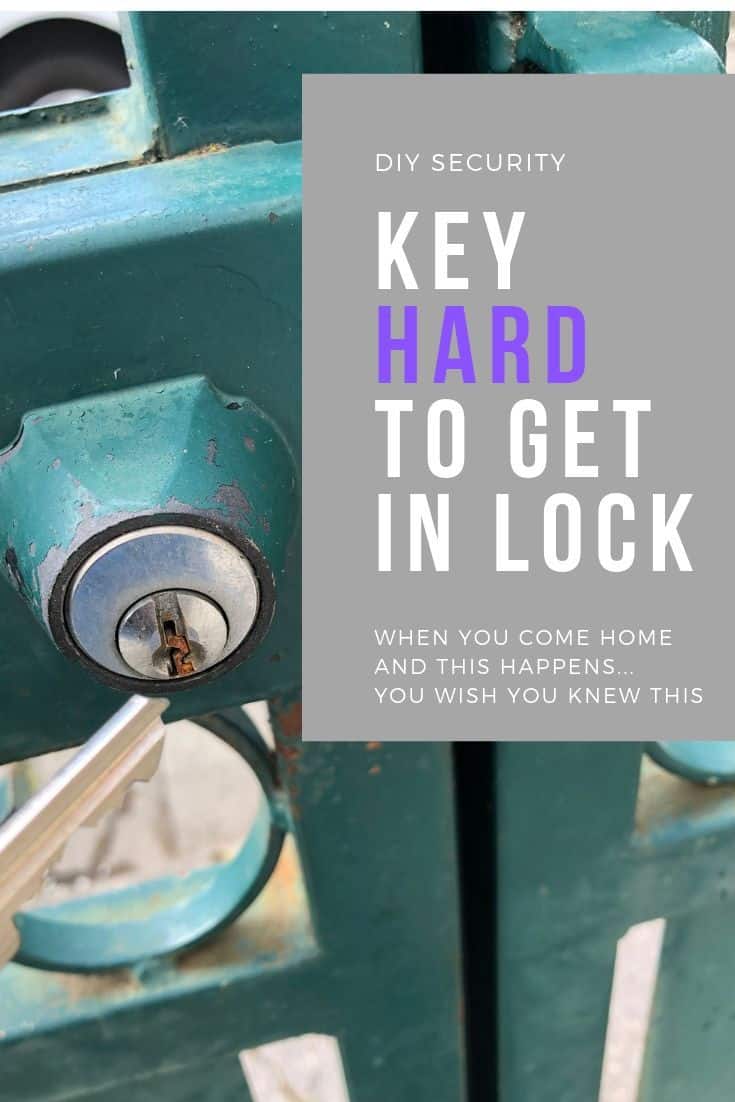
The lock is too dry
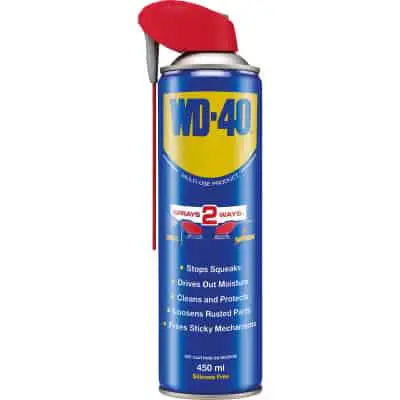
After years of use, rain, wind, dust, cold and heat, the mechanism of a lock is stuck. The pins don’t move anymore and the springs are not strong enough to overcome the added friction. There is no longer a single molecule of grease inside.
When you insert your key, the pins don’t go up anymore but sideways, at an angle, and the friction is just too strong. Don’t put anything inside just yet because it will form some sort of paste with the present dust.
Blow a couple of times, as strongly as you can, to remove dust. Alternatively, you can, of course, use compressed air.
Then, you can add some lubricant: WD40 or graphite powder, but not both as it might once again combine into a thick paste. If you’re in a hurry, don’t have anything on you, just use water or spit on the key… But lubricate as soon as you can afterward.
Your key should now go inside the lock.
Something is inside the lock
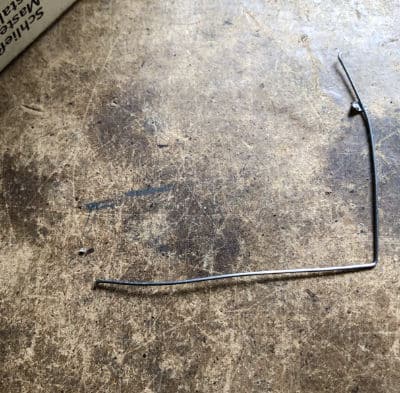
Take a light, maybe the light of your phone or smartphone. Look closely inside the lock.
There might be something in there, a debris, a foreign object: usually wooden matches, some paper, some electrical wire, a piece of broken key, or glue.
That is to say, someone is angry at you. Or it is a bad joke. Either way, here is how to take the object out of the lock :
- Matches
You are in luck, well kind of.
You should take a small wire if possible made of steel. Steel wires are stronger than iron wires or copper wires. You can use a piano or guitar small string. Try to make a small tiny hook with the wire cutter at one end. The wire shouldn’t slide easily: it should have a kind of rubber end to grab the pieces of matches. With this homemade tool, try to take everything out of your lock. You should succeed in a couple of minutes. End with a good blow inside the lock to remove the remaining dust. Insert your key. - Paper
Same method as above with a steel wire. Might be a bit longer to take out. Blow strongly. You should insert your key now. - Wire or paper clip
Easiest foreign object to take out: should go out in one go, no dust, nothing. A piece of cake. - Piece of broken key
Depending on where the key has been broken, it is deep or not. With your small steel wire, with trial and error, you should take the broken key out. With the wire cutter, improve your hook several times if needed. Remember to extract the broken key with a lock which hasn’t turned or start to turn, even slightly: if so, it will be impossible. Do NOT use glue to try to get the piece out. Read my complete guide on how to remove a broken key from inside a lock here. - Glue
No luck this time. There is no easy way to insert a key in a glued lock. You might end up drilling the lock, breaking a window, etc. Sometimes, if you heat up the lock and the key, really really hot, you can manage with melted glue to turn the lock just once and get inside. The lock is definitely broken and this trick is difficult to do with little tools just by yourself.
The key is bent, even slightly.
A key suffers wear and tear. It is always in your pocket, with you, on a ring together with other keys. This in itself can lead to wear.
The temptation is big to use a key as a tool, this is oh so common and we have all done so.
You might have (but shouldn’t have):
- Used your key to open a bottle as a can opener,
- Used your key to dig a hole as a drill,
- Used your key to open a box as a lever,
- Used your key to cut a rope as a saw,
- Used your key to open a door as a handle…
The list goes on and on and reflects our love and dependency towards this everyday object. Try to do all this with an RFID card!
The key is bent and the lock barrel is straight: it won’t fit. You should straighten the key, adjust and refine it as much as possible in order to be able to insert it into the lock. How to do so?
Ideally, use a vice bench and a small hammer: gently and slowly hammer the key on a straight and hard surface. You don’t want to be hard and flatten the key profile: you won’t be able to insert your key, this time for another reason. If the profile of the key is fragile and complicated, use a piece of wood between the key and the hammer.
If you don’t have a vice bench and a hammer, it might be a bit more complicated to straighten your key on the go, standing in your driveway or corridor.
First, you can try to insert the key as much as possible inside the lock and apply lateral force, gently once again, to straighten the key as much as possible. Don’t be too hard because you might break the key. Insert the key a bit more and repeat.
Or you can also try to put your key on a hard surface and use a heavy object like a hammer. Try to be as gentle as possible. A stone might be of help. Try not to flatten and damage the profile of the key.
A straighten key should go inside the lock, even with a little force applied and some lubricant, and you should open your lock.
Remember to replace your key, because a key which has been bent once will remain fragile. Replace it with a new key as soon as possible.
Blunt tip of the key
The key, when you look at it from the front, forms a shape, a special shape. This shape is an element of security (you can’t insert any key in any lock).
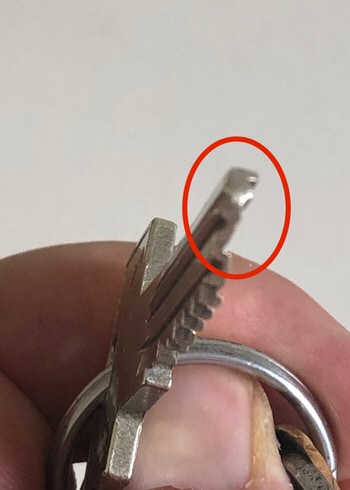
This shape is machined when the key is made. The higher the security of the lock, the more complicated this shape is. It is called the key profile.
Again, with the same types of abuses that we discussed in the precedent point (bent key), the key itself is not well machined anymore, especially the tip.
A damaged key profile presents thicker parts that can’t fit in the (inverse) profile of the lock. The tip of the key might get blunt or dull due to abuse, or the profile of the key flattened.
How to repair your key in order to be able to insert it again in your lock?
The best way is to have a close look at your key, from the front, compare it with the shape of the entry of the lock. Use the light of your smartphone if needed. Then you can see if the profile is damaged at the tip of the key. Usually, there is not much matter to remove in order to be able to use the key again.
Use a small bastard file to remove the excess of metal where needed. If you don’t have such a tool, a nail file might be enough. You can’t remove too much and go too far: there is no risk. Be patient, especially if you operate with a nail file, take your time. Try regularly to check your progress. With the help of some lubricant, you should be home in less than 15 minutes.
Stuck pins
The teeth of the key push upwards pins in the lock that go up against springs. With wear and tear and lack of lubricant, the pins become blunt at the tip and smaller in diameter. They can become really stuck. They become too small for their chamber, come up at an angle and stop on fatigue striations.
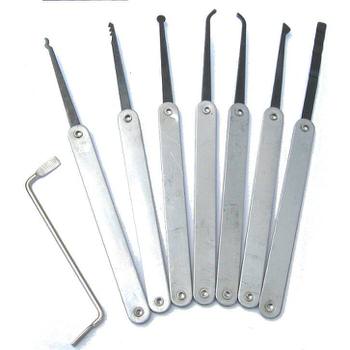
In that case, applying a lubricant can be enough. But usually, it isn’t. You should use a paper clip (or ideally a lock pick) to manually push up the pin. Once it goes up once, victory, you can insert the key and open your door.
Needless to say, even with good lubrification the problem might occur again. You should change your lock (or have a good locksmith re-pin it: it might be sometimes comparatively as expensive).
The user might be the problem
Check and double check: make sure your hand holds the right key. Many times we make a mistake and present the wrong key. This sounds silly, I know. But when we are tired or emotionally chocked our brain reacts strangely, and something that seems normal or usual can, in fact, be erroneous. It happened to me once.
For the birth of my first child, a little baby boy, ten years ago. My wife woke me up in the middle of the night because of water breaks. The bag was ready. I rushed out of bed and got dressed in the blink of an eye. The only thing I had to do was to take the car out of the garage and put the bag into the trunk… I couldn’t put the key in the lock! I just couldn’t and I tried very hard for long minutes. No way. My wife eventually went down and found me sweaty and shaking. She just took my key and turned! I won’t forget that sometimes locks won’t work because of us… Oh, and everything went well for the baby.
So keep calm, relax, breathe, double check your key and try again.

